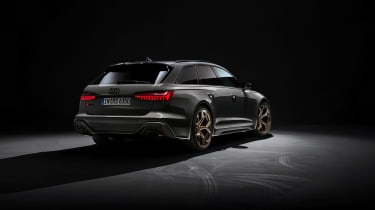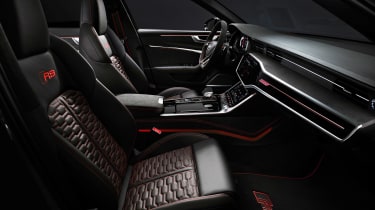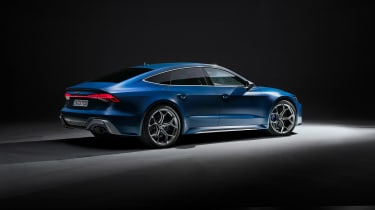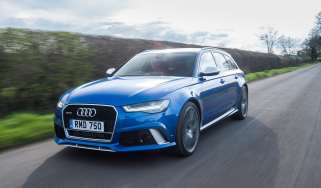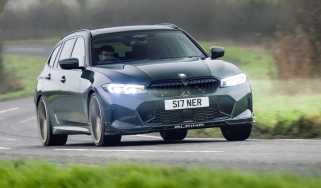Audi RS6 Performance debuts – new 621bhp variants to replace existing model
More power and less weight define the new RS6 Performance and its RS7 twin
Audi has revealed its new RS6 and RS7 Performance models, uprated variants of its V8-powered super estate and hatchback that now sit at the apex of Audi Sport’s four-door range. Unlike Audi Sport’s recent RS3 Performance, the new RS6 and RS7 models aren’t limited in number or availability as both replace their standard derivatives in the UK with a familiar set of three trim levels. Deliveries will commence in April next year with prices for the RS6 starting at £112,650 in its basic trim and rising to £130,050 for the fully-loaded Vorsprung; RS7s cost between £116,305 and £133,705.
Both Performance models have picked up a collection of small detail changes alongside the extra power, designed largely to increase their emotional appeal. So while the on-paper figures are up from the existing twin-turbocharged 4-litre V8 engine – now producing 621bhp (up from 592bhp) with 627lb ft of torque, itself a considerable 37lb ft increase – Audi’s also removed of some of the sound deadening between the cabin and firewall to allow more of the rumble to reach the cabin.
Audi Sport has reached these new figures by turning up the boost on its twin-turbochargers, rising from 2.4 to 2.6bar. Performance times from standstill to 62mph have dropped by 0.2sec for both, reaching the benchmark in 3.4sec, 0.1sec behind the current M5 Competition. Unlike the RS4 Competition there are no software changes to the eight-speed automatic transmission, and the quattro all-wheel drive system is also as it was.
All RS6/7 Performance models do now come with the RS Dynamic package as standard, though, lifting the limited top-speed from 155mph to 174mph, while also bundling in rear-axle steering with a specific calibration for the Performance models and a torque-vectoring rear differential. On top of this is an optional RS Dynamic Plus package which increases the top speed yet again, this time to 189mph (limited), and brings in Audi’s mammoth 440mm front and 370mm rear carbon ceramic brake package. These are gripped by ten-piston calipers on the front axle and four-piston units on the rear and can be specified in grey, red or black.
The other new addition to the Performance models are a fresh set of milled 22-inch wheels, standard on the Carbon Black and Vorsprung models. These are a similar design to those first seen on the RS4 Competition, albeit a couple of inches bigger in diameter, and thanks to a lightweight forged construction weigh 5kg less per unit than the existing 22-inch rims. This makes them 20kg lighter in total, which when combined with the carbon ceramic brakes adds up to a huge 54kg reduction in total unsprung weight. In conjunction with the other lightweighting measures such as the noise insulation previously mentioned, the RS6 Performance’s weight is down from 2175kg to 2090kg in its lightest specification – the RS7 Performance is lighter still at 2065kg.
Along with the wheels are new 285/30 R22 Continental SportContact 7 tyres, the next generation of high performance rubber that Audi says gives better grip in both wet and dry conditions with even more precision. They also reduce the stopping distance from 62mph by two metres.
> Audi R8 V10 RWD GT 2022 review
Standard on Vorsprung models – and optionally available on other specifications – is Audi’s Dynamic Ride Control (DRC) suspension system. This replaces the standard car’s air system with steel coil springs and hydraulically cross-linked dampers. In our experience with the existing RS6 and RS7, the high-spec dampers are a very worthy upgrade, giving both more clarity to its road feel and a more resolute hold on ultimate body control. This comes without any major disadvantages in ride quality too, and also eliminates the air system’s propensity to shudder over small bumps.
Aside from the new wheels, both new Performance models can be picked out visually by the new exterior colours, significantly increasing the palette to 16 options including two matt finishes. The milled wheels are also able to be finished in various colour options including a dusty gold colour, while the carbonfibre accents on the Carbon Black variant now have a darker tint to their resin finish.
Inside, there are further colour options that integrate either grey, red or now blue contrasting stitching into the leather-wrapped seats, door panels and dashboard. There are also optionally corresponding coloured threads that can be integrated into the carbonfibre inlays, and there’s now standard fitment of Dynamica to the steering wheel and gear selector. The RS’s Virtual Cockpit has also picked up some new graphics, including a new motorsport-inspired shift light in either of its RS drive modes.
The new RS6 and RS7 Performance models will soon be available to order, with first cars reaching customers in the UK from April 2023. As for rivals, both of the fast Audis’ traditional rivals are either between generations or coming to the end of their current one. BMW’s M5 Competition is still available, but will be replaced in early 2024 by a new hybrid-powered replacement. The RS7-rivalling BMW M8 Competition Gran Coupe has only just been updated, and starts at just over £135,000. The next generation Mercedes-AMG E63 S (likely with an ‘E Performance’ moniker attached to the end of it) will likely arrive around the same time as BMW’s next M5, but we know little about its potential powertrain and whether it’ll mimic the smaller C63 S E Performance with a four-cylinder hybrid setup.
Either way, the super saloon and super estate worlds are changing, with most if not all rivals adopting a plug-in hybrid powertrain in their upcoming generations. This is a path Audi Sport will almost certainly follow, which also means this could be the last V8-powered RS6.


